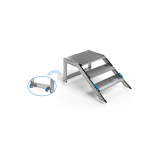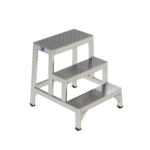Standards and Regulations for Working at Height
At ESLA, we offer innovative and customized solutions for working at height with complete confidence. Our products are designed and manufactured in accordance with the most demanding international standards, which guarantees their durability and performance.
Thanks to our commitment to excellence, backed by EN ISO 9001 certifications, every platform and ladder we manufacture meets the highest quality and safety standards, ensuring an optimal and safe working environment.

Key Certifications and Standards for Safe Access Equipment
ISO 9001
It is an international standard that establishes the requirements for a quality management system (QMS). Its objective is to ensure that companies offer products and services that meet customer expectations and applicable regulations.
The standard promotes continuous improvement, operational efficiency, and customer satisfaction. It is applicable to any type of organization, regardless of its size or sector. ISO 9001 certification reflects a company’s commitment to quality and excellence.

EN 131 - Ladders
The EN 131 standard is a European norm that establishes safety requirements and technical specifications for portable ladders. This standard addresses aspects such as design, construction, strength, stability, and safety features of portable ladders used in various environments. All ESLA ladders comply with this standard.
The EN 131 standard is composed of several parts, each addressing specific aspects related to portable ladders.
- EN 131-1: Terminology, types and functional dimensions.
- EN 131-2: Requirements, testing and marking.
- EN 131-3: User information.
- EN 131-4: Single or multiple hinge-joint ladders.
- EN 131-6: Telescopic ladders.
- EN 131-7: Mobile ladders with platform.
The EN 131 standard, modified in 2017, incorporated new aspects that we at ESLA have adopted.
According to the latest version of the EN 131 standard, all ladders must meet additional and stricter requirements. Here are some examples of these new requirements and tests that have been implemented.
BASE WIDENING
All leaning ladders with an extended length greater than 3,000 mm must have a widening at the base, such as a crossbar.
The length of the widening varies depending on the ladder, with a maximum of 1,200 mm.
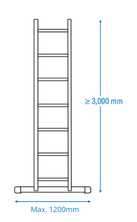
TORSION TEST FOR STEPLADDERS
A 500 mm steel bar is placed on the top rung and the ladder is secured by the stile.
A load of 736 N (75 kg) is applied and then 137 N (14 kg) at the end of the bar in the opposite direction.
The unfixed base can move up to 25 mm.
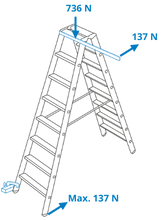
DURABILITY TEST
A load of 1,500 N is applied alternately between the top rung and the middle rung of the ladder.
- For non-professional use: 10,000 cycles.
- For professional use: 50,000 cycles.
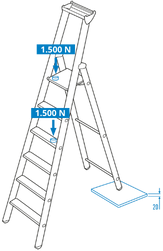
RUNG STRENGTH TEST
The rung must withstand a load of 2700N in case of “”Professional category or 2250N in case of “”Non-professional.

BASE SLIP TEST
The ladder is placed on a defined surface, a load of 1,471 N is applied and repeated four times. The ladder cannot slip more than 40 mm.
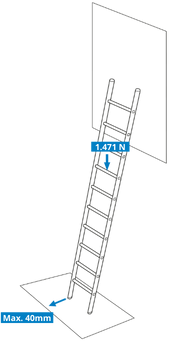
TORSION TEST FOR LEANING LADDERS
The ladder is placed on two trestles, loading both stiles with 491 N for 30 seconds and measuring the deflection
Then, one stile is loaded with 638 N and the deflection is measured again. The difference between both measurements cannot exceed the predetermined limit.
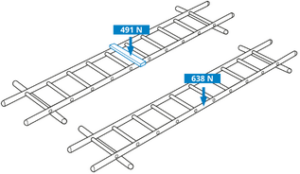
EN 14183 – Step Stools and Steps
The EN 14183 standard is a European directive that establishes safety and performance requirements for step stools and steps. This standard covers a wide range of aspects, ensuring their stability, strength, and safety under conditions of use.
EN 14122 - Permanent Means of Access to Machinery and Industrial Installations
The EN 14122 standard is a set of European standards that establishes safety requirements for stairs, ladders, walkways, and guardrails used in access and exits of industrial equipment and installations.
The EN 14122 standard is divided into 4 parts:
- EN 14122-1: Selection of fixed means of access and general access requirements.
- EN 14122-2: Working platforms and walkways.
- EN 14122-3: Stairways, stepladders and guard-rails.
- EN 14122-4: Fixed ladders.
The EN 14122 standard establishes differentiations according to the angle of inclination of the access ladder. These differentiations are important because the angle of inclination directly affects the safety and comfort of users.
- Fixed ladder – 90º < 75º
- Step ladder – [45º, 75º]
- Staircase – [20º, 45º]
- Ramp – >20º

EN 1004 - Mobile Access and Working Towers
A standard for mobile access and working towers assembled with prefabricated components, which includes specifications on materials, dimensions, load calculations, and safety requirements. EN 1004 provides a set of standards for the design and safe use of mobile work towers, ensuring they are stable, safe, and easy to use in professional environments.
EN 61478 - Ladders of Insulating Material
The UNE-EN 61478 standard applies to fully insulating ladders or those composed of a combination of conductive and insulating sections, used in live working, both in alternating current and direct current installations. The standard covers a nominal voltage of 1,000V or more for alternating current and 1,500V or more for direct current. It is important to note that this standard applies exclusively to ladders manufactured with synthetic materials.
These ladders are mainly used to provide access for work on electrical installations, such as overhead power lines, and allow tasks to be performed live, either at a distance, at potential, or a combination of both.

